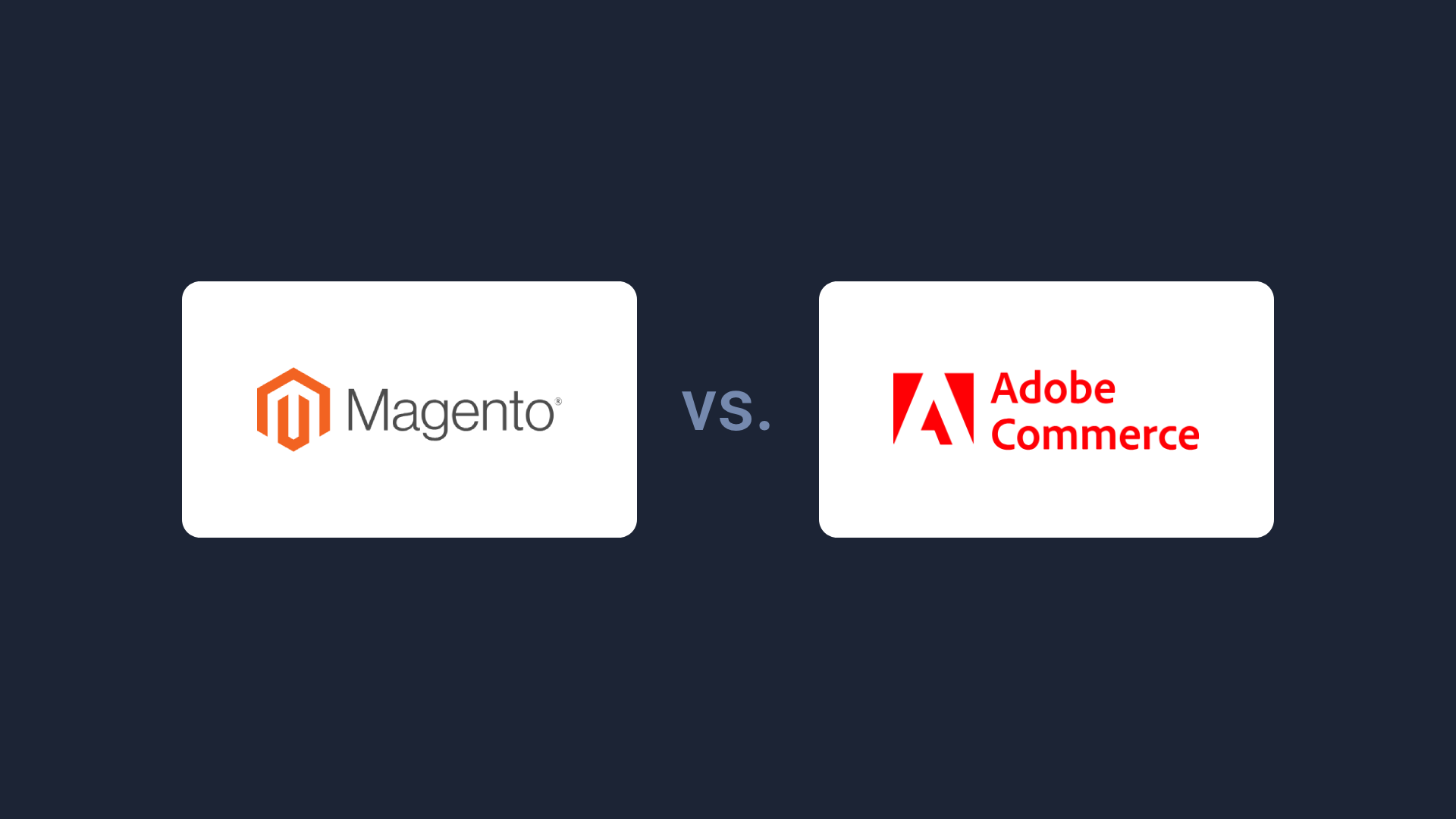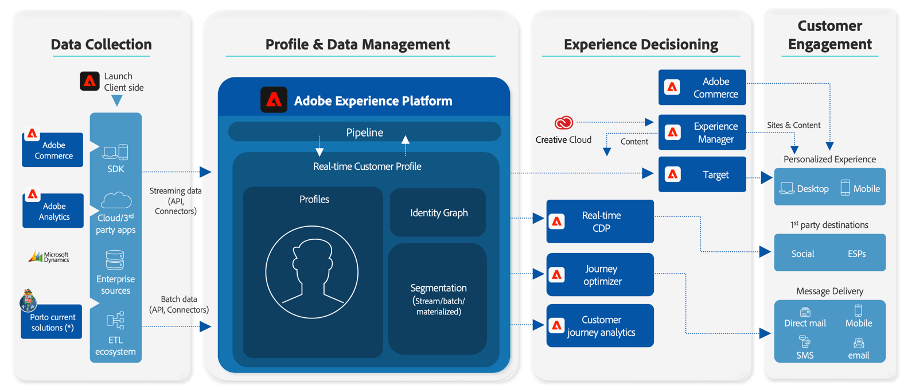Official Partners
Certified official partners of the most renowned ecommerce solutions.
Toogas-AIP Webinar «Automation and Operational Efficiency in Ecommerce»
- Services
- Implementation of B2B and B2C Ecommerce Solutions
- ERP / CRM / OMS Integration and Automation
- Platform Migration and Upgrade
- Ecommerce Evolution and Support
- Digital Marketing – KPI-Driven
- Analytics, Insights and Data Reporting
- Applied Artificial Intelligence (AI)
- Ecommerce Audit and Consulting
- User Experience (UX) and Interface (UI)
- Portfolio
- Technologies
- Clients
- About
- Contacts
Magento Open Source vs. Adobe Commerce

Magento Open Source vs. Adobe Commerce / Which E-commerce Solution Is Best for Your Business?
Choosing the right e-commerce platform is a crucial decision that can determine the success of your online business.
Magento Open Source and Adobe Commerce are two popular solutions, each offering distinct features tailored to the needs of different businesses.
While Magento Open Source is a flexible, open-source platform ideal for smaller organizations, Adobe Commerce provides more comprehensive functionalities and advanced support, designed for larger enterprises.
In this article, we will explore the differences between these two systems and help you determine which option is best suited for your business.
The Development History of Magento and Adobe Commerce
Since its launch in 2008, Magento quickly became a highly versatile open-source e-commerce platform. Thanks to its flexibility and strong community support, it has served as the foundation for numerous businesses, offering full customization to meet diverse business requirements. At the same time, a paid version, Magento Enterprise Edition, was introduced for larger organizations, providing additional features and a higher level of support.
Adobe’s acquisition in 2018 shifted the platform’s development trajectory, transforming Enterprise Edition into Adobe Commerce. Integration into the Adobe ecosystem added analytics, personalization, and content management capabilities, allowing greater control over complex e-commerce operations and enabling global expansion.
Adobe Commerce, also available as a cloud-based solution, has become a top-tier enterprise platform for companies requiring scalability and a more robust infrastructure.
Meanwhile, the original Magento Open Source has remained a free, community-driven version, ideal for smaller businesses seeking technological independence. With a rich ecosystem of extensions, it continues to be a popular choice for companies wanting full control over code and infrastructure.
Today, both platforms represent distinct growth paths: Magento Open Source as a flexible starting point, and Adobe Commerce as a solution tailored for large enterprises, unifying sales and marketing within a single ecosystem.
Differences Between Magento and Adobe Commerce
The choice between Magento Open Source and Adobe Commerce depends on the specific characteristics of the project, as well as business and technical requirements. While both are built on the Magento platform, they differ in terms of cost, features, and implementation scale.
License Costs
Magento Open Source is free software, allowing businesses to use the platform without incurring license fees. It is an excellent option for organizations looking to reduce costs and invest in other areas of the business. However, due to Magento’s extensive architecture, implementation and ongoing development may require collaboration with a specialized e-commerce agency or the formation of an internal technical team. Therefore, despite the absence of license costs, resources must be allocated for customization, maintenance, and store optimization.
Adobe Commerce is a paid solution, with license costs based on the store’s annual revenue. In return, larger businesses gain access to advanced features and specialized technical support, making Adobe Commerce an attractive choice for companies with higher operational demands.
Hosting
Magento Open Source allows complete freedom in choosing a hosting provider, offering flexibility but also requiring management of the server infrastructure. It is necessary to select a hosting service that meets performance requirements and site load demands, which may require specialized technical support or an internal IT team.
Adobe Commerce can be installed both on-premises (similar to Magento Open Source) and in the cloud (Adobe Commerce Cloud). In the cloud version, the infrastructure is provided by services such as Amazon Web Services (AWS), Microsoft Azure, or Google Cloud Platform. This option includes server management and optimization, as well as automatic resource scalability, eliminating the need for an internal IT team or external provider.
Features
Magento Open Source provides a robust set of tools to manage essential e-commerce aspects such as product catalogs, orders, payments, and shipping. The platform supports multiple currencies and languages, making it suitable for businesses planning international expansion. Being open-source, Magento Open Source offers great flexibility for integrating third-party modules and customizing features to meet specific business needs. Additionally, the Magento Marketplace allows stores to expand with various extensions, including discount systems, sales analytics tools, marketing modules, and SEO enhancements.
Adobe Commerce extends the standard Magento Open Source features with a wide range of solutions designed to manage more complex e-commerce projects:
AI-Powered Recommendations: Using Adobe Sensei, the platform provides real-time product suggestions, increasing customer engagement.
Advanced Catalog Management: Offers detailed control over products and pricing, essential for stores operating in both B2C and B2B environments.
Real-Time Search: AI capabilities ensure fast and accurate search results, enhancing the user experience.
Loyalty Programs and Gift Cards: Integrated tools that simplify the creation of loyalty programs and the sale of gift cards.
Content Staging: Enables scheduling content changes and planning updates without disrupting store operations.
Scalability and Technical Support
Magento Open Source allows complete freedom in choosing a hosting provider, offering flexibility but also requiring management of the server infrastructure. It is necessary to select a hosting service that meets performance requirements and site load demands, which may require specialized technical support or an internal IT team.
Adobe Commerce can be installed both on-premises (similar to Magento Open Source) and in the cloud (Adobe Commerce Cloud). In the cloud version, the infrastructure is provided by services such as Amazon Web Services (AWS), Microsoft Azure, or Google Cloud Platform. This option includes server management and optimization, as well as automatic resource scalability, eliminating the need for an internal IT team or external provider.
Why Choose Magento Open Source?
Here are several reasons to opt for Magento Open Source:
No License Costs
Magento Open Source is free, offering a significant advantage for businesses seeking a cost-effective e-commerce solution. This allows investment to be redirected to other areas of the business, such as marketing initiatives or product development.
Flexibility and Customization
As an open-source platform, it enables full adaptation to the unique needs of each business. Almost every element of the store can be modified, and custom solutions can be created. Additionally, the Magento Marketplace offers numerous free and paid plugins that extend functionality without requiring development from scratch.
Community Support
Magento Open Source benefits from a global community of active developers, providing technical guidance and a variety of resources, including forums, discussion groups, and specialized documentation. This support facilitates quick problem-solving and allows businesses to leverage the experience of other users.
Self-Hosting
Magento Open Source requires users to select and manage their own hosting, providing full control over server infrastructure. This freedom is advantageous for businesses that want to independently manage performance and security aspects.
Essential E-commerce Features
Even as the free version, Magento Open Source offers all essential tools for a modern online store, including product management, order processing, payments, support for international sales, and mobile optimization.
Why Choose Adobe Commerce?
Here are the main advantages of Adobe Commerce:
Advanced Features for B2B and B2C
Adobe Commerce provides specific solutions for B2B sales, including catalog management, detailed customer control, and tools for price negotiation, shopping lists, and bulk ordering. This makes it particularly suitable for businesses with larger-scale sales structures.
Integration with the Adobe Ecosystem
The platform can be integrated with other Adobe Experience Cloud services, such as Adobe Analytics, Adobe Experience Manager, and Adobe Target. This synergy enables a fully personalized customer experience, more efficient content management, and access to analytics tools that support marketing, sales, and customer retention.

Enterprise Technical Support
Adobe Commerce provides official technical support, ensuring immediate assistance for problem resolution. With 24/7 support and regular updates, the platform remains secure and stable — crucial for large-scale businesses where any downtime can result in significant financial losses.
Cloud Hosting
The cloud version of Adobe Commerce provides a fully managed infrastructure, eliminating the need for client-side technical management. Servers scale automatically, and the platform includes tools to monitor performance. This allows businesses to focus on growth without having to manage the underlying technology.
Security and Scalability
Adobe Commerce is designed to handle large-scale e-commerce operations, offering advanced security features such as data encryption, DDoS protection, and PCI compliance, ensuring the safety of customer data and transactions. Additionally, it is highly scalable, allowing businesses to grow without compromising stability.
How to Choose the Right E-commerce Solution
The decision between Magento Open Source and Adobe Commerce should be based on a careful analysis of business needs and long-term expansion plans. It is not just a matter of comparing license costs or features, but also evaluating the level of support, flexibility, and the company’s ability to adapt its e-commerce environment to the ever-changing market.
Both platforms, despite their differences, can effectively support business growth at any stage, provided they are properly aligned with the company’s strategy and resources.
If the priority is maintaining detailed technical control and saving on license costs, Magento Open Source may be the ideal choice. For those who value more robust features, specialized support, and integration with the Adobe Commerce Cloud ecosystem for marketing and data analytics, Adobe Commerce emerges as the most comprehensive option.



